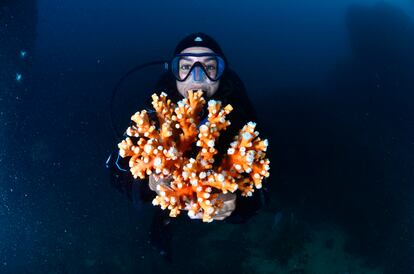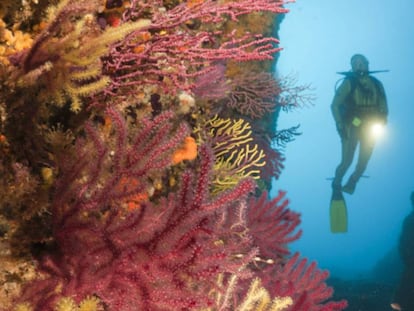Protecting coral off the coast of Granada
An NGO has created one of the first nurseries in the Mediterranean to restore and conserve an important colony of the species which is threatened by waste from the fishing industry

In the Spanish resort town of Almuñécar, along the Granada coast in Andalusia, there is a stretch of land that juts out into the Mediterranean. Its surface is covered by a labyrinth of housing developments and villas with pools while around it are cliffs and beyond that, a marine paradise.
In the 120 hectares that make up the Punta de la Mona Special Area of Conservation (ZEC), there are reefs, and a seabed that is both rocky and sandy with high levels of biodiversity and dense populations of endangered species, according to the regional authorities of Andalusia. Among these species are the orange coral (Astroides calycularis) and the candelabrum coral (Dendrophyllia ramea). The latter is rare on this coast. It usually develops in isolated areas and at a depth of more than 50 meters, but here it has grown into a large colony of between 500 and 1,000 specimens at a depth of just 30 meters. But lack of awareness and protection, combined with the impact from the fishing industry, has been endangering this precious underwater garden for decades. Now, the SOS Corals project developed by the NGO Equilibrio Marino (Marine Balance), is setting up one of the first coral nurseries in the Mediterranean. The idea is to install several underwater structures where damaged specimens can recover and healthy samples can be added to help repopulate the colony.
It is urgent we take care of the sea: it is a source of life, a climate regulator and absorbs large amounts of carbon dioxideFernando Alarcón, founder of Equilibrio Marino
The water quality, the underwater relief system and the marine currents have combined to create the right conditions along this part of the coast for a large population of this species – listed as “vulnerable” on the International Union for Conservation of Nature’s (ICUN) Red List of Threatened Species. Importantly, it provides an ecosystem that shelters a large number of fish and invertebrates that feed and reproduce in this environment, with octopus, bream and starfish being among the dozens of species mentioned in a study by the Spanish National Research Council (CSIC).
The unique population of candelabrum coral barely advances one centimeter per year as the coral polyps feed on plankton. This contrasts with its accelerated rate of deterioration. As Marina Palacios, coordinator of SOS Corals, explains: “This colony that has hundreds of specimens is in serious danger because it is hugely vulnerable to nets, hooks, lines, traps and other fishing gear, which strangle, fragment and cover the corals, killing them.” Like many other specialists, Palacios warns that the candelabrum and other coral species need greater protection to survive in a sea that is overfished and threatened by climate change.
Palacios was born in Segovia in Castile and León 30 years ago, almost 300 kilometers from the beach, but she has always harbored a passion for the sea and studied Environmental Sciences in Cádiz, later specializing in reef recovery. Now she is fulfilling her dream in one of the first projects of its kind in the Mediterranean, working in an area of half a thousand square meters along the coast of Granada, near the crystal-clear waters of La Herradura.
“It is a very important area,” says Agustín Barrajón, a naturalist who has been diving along the Andalusian coastline for 30 years and acts as a consultant for the University of Málaga and other public bodies for conservation reports.
The SOS Corals initiative took shape after Equilibrio Marino divers noted the progressive degradation of the coral. “Many people also saw that the coral was dying and asked us what they could do, because something had to be done,” says Fernando Alarcón, founder of the NGO. “But it is a species that requires knowledge and permits, so we decided to promote this initiative.”
The project got financing through an international contest held by the French organization, Coral Guardian, while contributions from individual donors have helped to make it possible without public funding. “Hopefully, more will join in the near future, because we still need funding,” says Alarcón, who points out that the economic crisis caused by the coronavirus pandemic has meant several potential sponsors were unable to support the project.
Under Palacios’ management, Equilibrio Marino employees began to map the seabed where the coral colony is established last September. Thanks to technology, the team has been able to identify how much coral there is and where it is located, as well as the damage suffered by each specimen and the amount of waste in its vicinity.
This stage has run parallel to a genetic and reproductive study of the corals undertaken at the universities of Cádiz, Málaga and Granada. Meanwhile, the environmental parameters are being analyzed using two sentinel stations that flag up currents, water quality and the amount of plankton and pollutants in the sediment; so far, more than 500 of these have been found, from products such as sunscreen, perfumes and heavy metals.
After dividing the area into small quadrants, a team of divers trained specifically for the purpose, along with about 30 volunteers, began with the practical work on a plot of approximately 50 square meters, removing up to 250 kilos of heavy dry waste, 98% of which comes from the fishing industry. The most significant items were 200 meters of rope, three kilometers of fishing line and 300 meters of net, along with other elements such as tires. The NGO’s data indicate that eight out of 10 specimens are damaged, so once the waste is removed, the divers dedicate themselves to cleaning each coral individually during three-weekly dives of between one and two hours, separating the dead bits, removing the sediments and also the epibionts, or colonizing parasites, that damage the species. Finally, the divers return the corals to their environment with non-intrusive techniques to avoid the displacement of other species. They also recover the broken segments that are scattered on the seabed and use them to repopulate thinned-out areas.
The divers removed 200 meters of rope, three kilometers of fishing line and 300 meters of net from just one part of the area
“The problem is that in many cases the broken corals have been at the bottom for a long time or have been strangled or have received too many blows,” says Palacios. “This makes their natural recovery unlikely as there are other opportunistic species, such as epibionts, that settle on the wounds and end up killing them.” This is where the nurseries come into play. They are comprised of small metal tables that are placed on the seabed, offering a safe environment away from sediment and invasive species. The more damaged corals are anchored on the frame and receive special treatment to help them recover – from careful cleaning to the use of a special resin to heal their wounds. This is sometimes also reinforced with the use of small fish that feed on the algae and other debris left on the corals. “We have called them nurseries because they are like small children; they require a lot of care,” says Alarcón, who explains that, when the specimens have regenerated, they will be returned to their original ecosystem. The specialists also ask divers who pass by these nurseries to keep their distance to avoid damage.
For the moment, the NGO has installed just one structure with the second to be installed once the waste has been removed and the corals in the second plot treated. According to those in charge, the work on the second plot will not start until all the work on the first is finished. The idea is to install five of these structures in the coming months so the recovery of all the specimens can occur over a period of about three years.
“There is enough accumulated waste to provide work for a minimum of two years,” says Alarcón. The idea is that the entire coral garden will be healthy by 2025 at the latest. The final objective is the creation of a Marine Protected Area that will attract diving tourism and, at the same time, serve to prohibit fishing. As Palacios points out, “It has been demonstrated that the protection of this species and all the diversity of the zone it inhabits is not compatible with fishing activity, which has very harmful effects on the ecosystem.” Naturalist Agustín Barrajón adds that he would also ban diving or restrict it to very specific activity as the decanting involved can have a significant impact on the coral.
Meanwhile, Alarcón and his team plan to carry out training and awareness campaigns to involve more people in marine conservation. “It is urgent we take care of the sea: it is a source of life, a climate regulator and absorbs large amounts of carbon dioxide,” he says.
English version by Heather Galloway.


